If you've been wondering how to make onion powder, you may be surprised how easy it is to make! This fresher, better tasting version of a pantry staple is made by dehydrating onions and grinding them into a fine powder. Make your own homemade onion powder today!
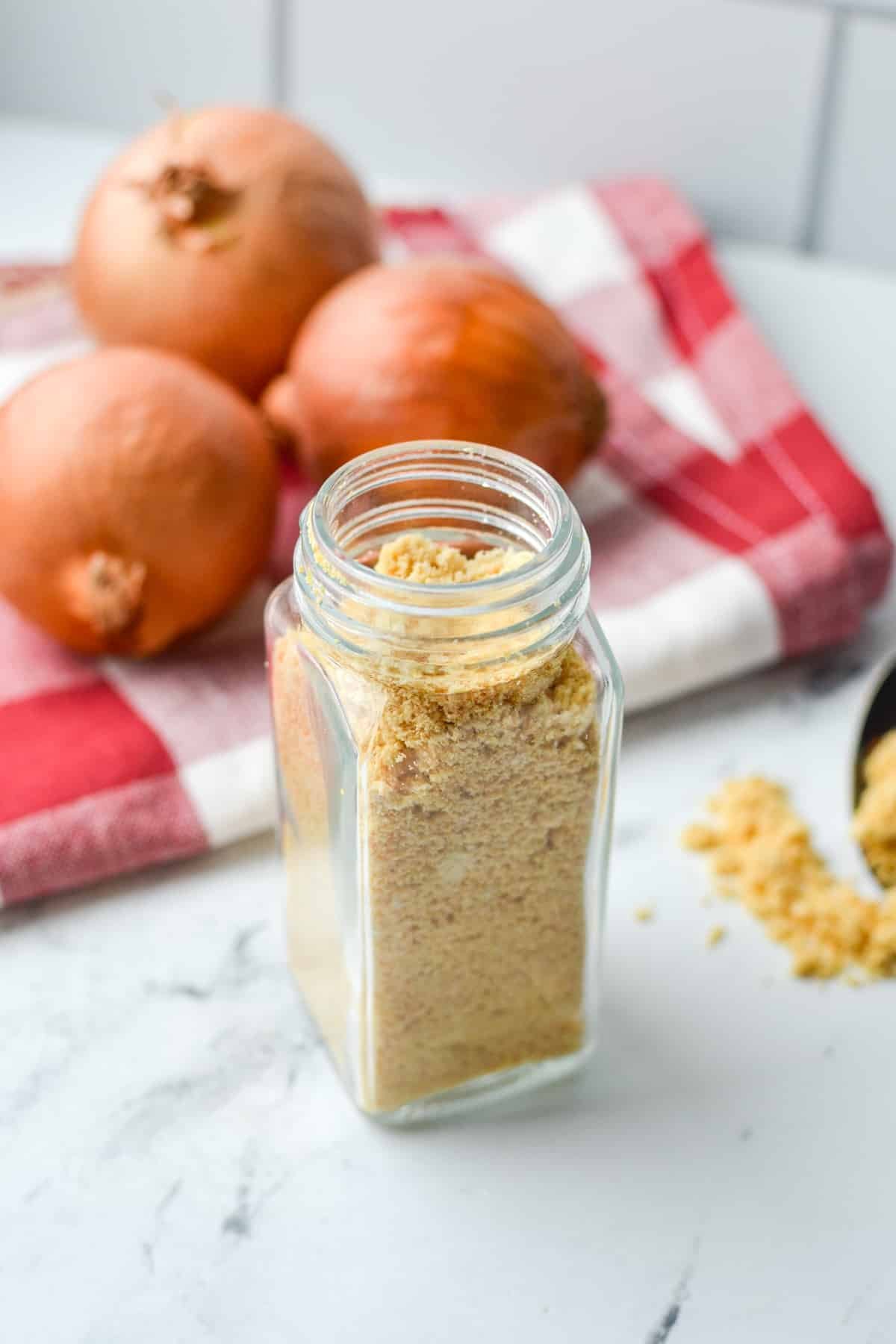
I've talked many times before about my journey to make more foods at home and learn methods of preserving like canning, fermenting, and dehydrating. I've learned a lot over these past 10 or so years (I'm too scared to count), and now I love sharing any knowledge I've gleaned here on my blog.
This recipe/method for homemade onion powder is a great way to turn dehydrated onions into onion powder - which is an ingredient that is very common in your average kitchen. It also tastes amazing, and is quite easy to make with basic equipment.
Why Make Homemade Onion Powder?
- It tastes WAY better than anything you can buy at a store.
- Great way to preserve a bumper crop of onions, or varieties that don't store as well.
- A fresher taste than store-bought versions that have been sitting on a shelf for months.
- Can use organic or your favorite type of onion for a completely custom result. You could even do a blend of onions!
Ingredients and Equipment
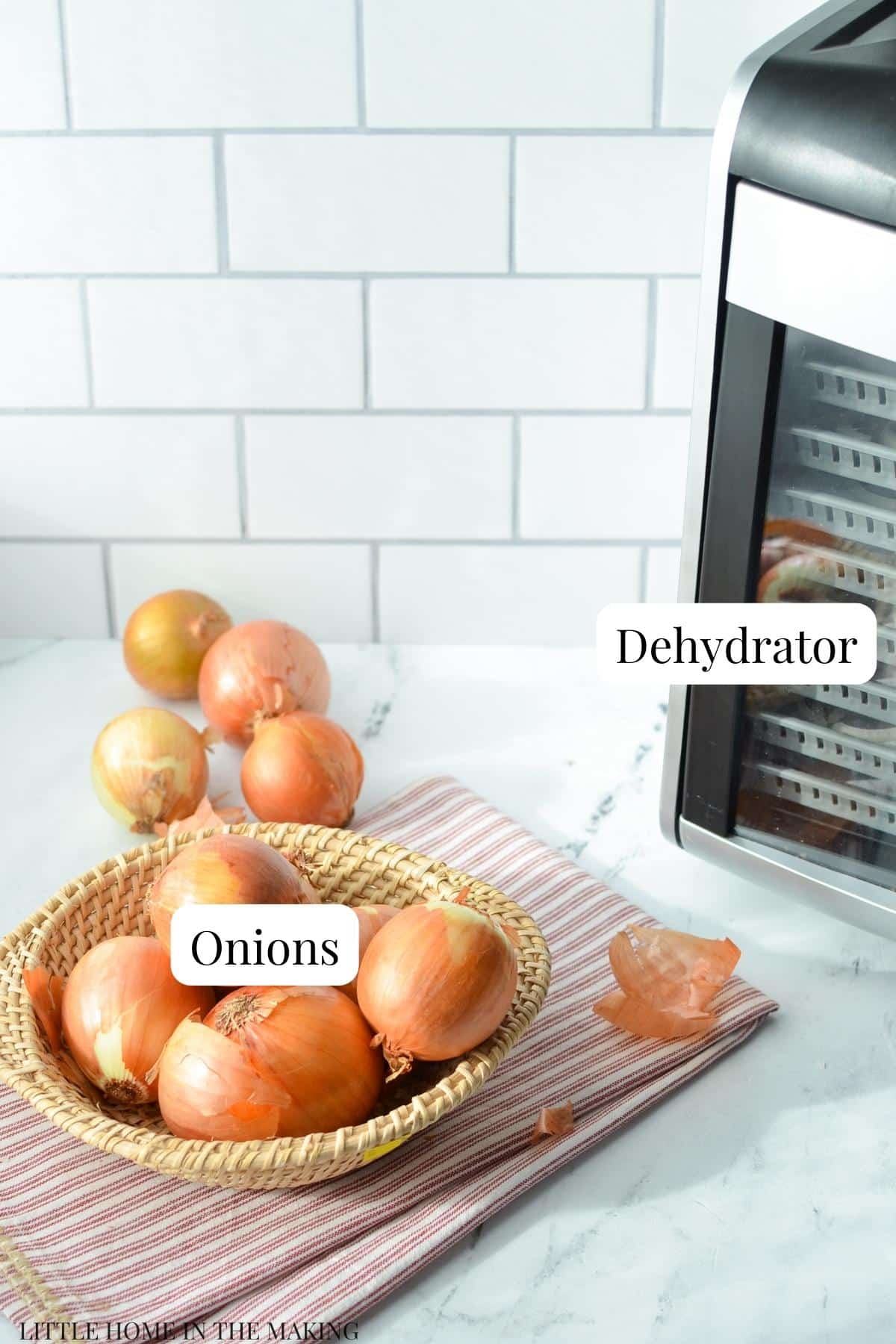
- Onions: This recipe works for regular yellow cooking onions, red onions, and even sweeter onions like Vidalia.
Equipment and Tools
- Dehydrator OR oven: I recommend using a dehydrator (like this Excalibur model) for drying onions, but you can use a low setting on your oven if you haven’t made the investment yet.
- Spice grinder or coffee mill: In order to grind the dried onions into a powder I recommend using a spice grinder or coffee grinder that is set aside specifically for that purpose. I have one that I use to make homemade powders – because no one wants an onion-infused cup of coffee.
- Parchment paper OR dehydrator liners: Since minced onion is small in size you’ll need to line your dehydrator trays if they have large holes like the one I used. If you have fine mesh screens – no worries.
- Glass jar: A glass jar with a lid is needed for conditioning the dried onions. Conditioning ensures that the food is fully dried and redistributes moisture if necessary. It can also be used for storing your homemade onion powder.
How to Make Homemade Onion Powder
If you've already started the process and made some dehydrated onions, you're ahead of the game and ready to go! If not, stay tuned and I'll show you how to dry your onions before we get started with the actual powder making process.
Drying the Onions
Peel your onions and remove the thin membrane just under the skin. Then either slice into half moon shapes OR chop it finely. For the purposes of making onion powder I find the half moons a bit quicker to dry and easier to manage.
Spread the onion pieces out in a single layer on a parchment lined dehydrator tray (only if your model doesn't have a mesh screen).
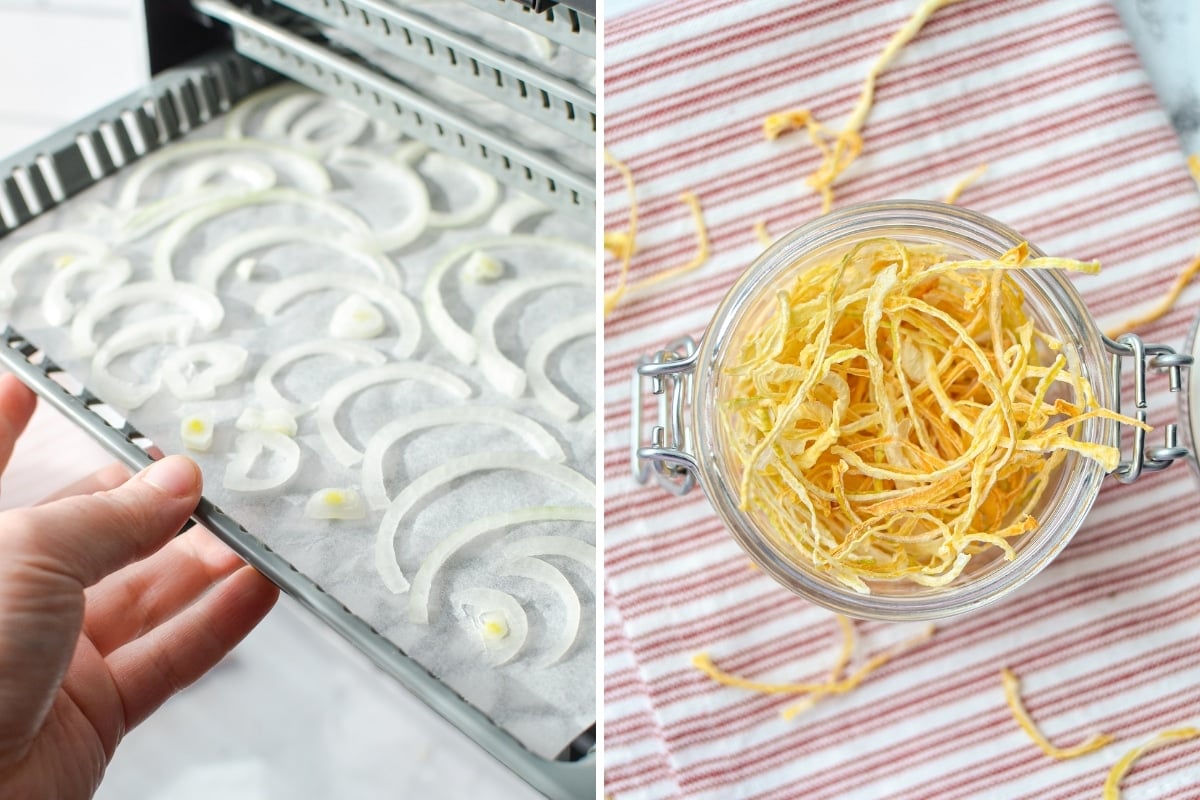
Dehydrate your onions for 10-24 hours at 125ºF (52ºF) or until they are very brittle, dry, and snap in half easily.
Allow the onions to cool completely to room temperature - either inside of the turned off dehydrator, or by placing the trays on the counter for an hour. Once they are completely cooled you're ready to move onto the next step: conditioning.
Conditioning Dried Onions
Conditioning is a process I recommend with all of my dehydrator recipes. It ensures that your food is dry enough to store safely, and allows you to dry it further if needed while you still have the ability to do so.
For making homemade powders it is especially important, since a moist powder will not keep.
To condition: place the cooled dried onions in a glass jar fitted with a lid. Place on the counter out of direct sunlight, shaking the jar several times over the next 24 hours. If there are no signs of condensation or moisture after 24 hours have passed, you're good to store your onions or grind them into powder.
Grinding Into Powder
Add the completely dried (and conditioned) onions into a coffee or spice grinder in small batches, pulsing until it breaks down into a fine powder.
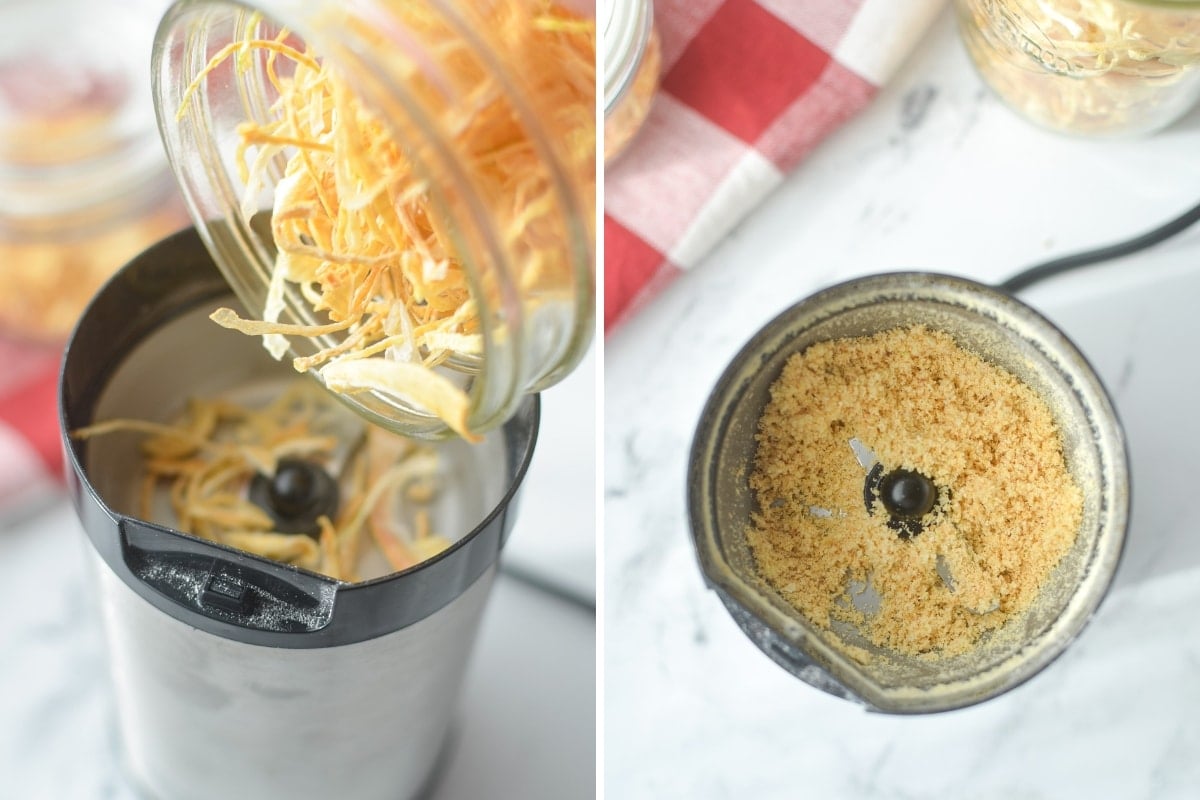
You may notice that your onion powder is very clumpy when compared to garlic powder, and this is fairly normal. But if it is very clumpy, there still may be some excess moisture in the powder.
If your onion powder seems moist or very clumpy, try dehydrating it for a second time.
Dehydrating a Second Time (If Needed)
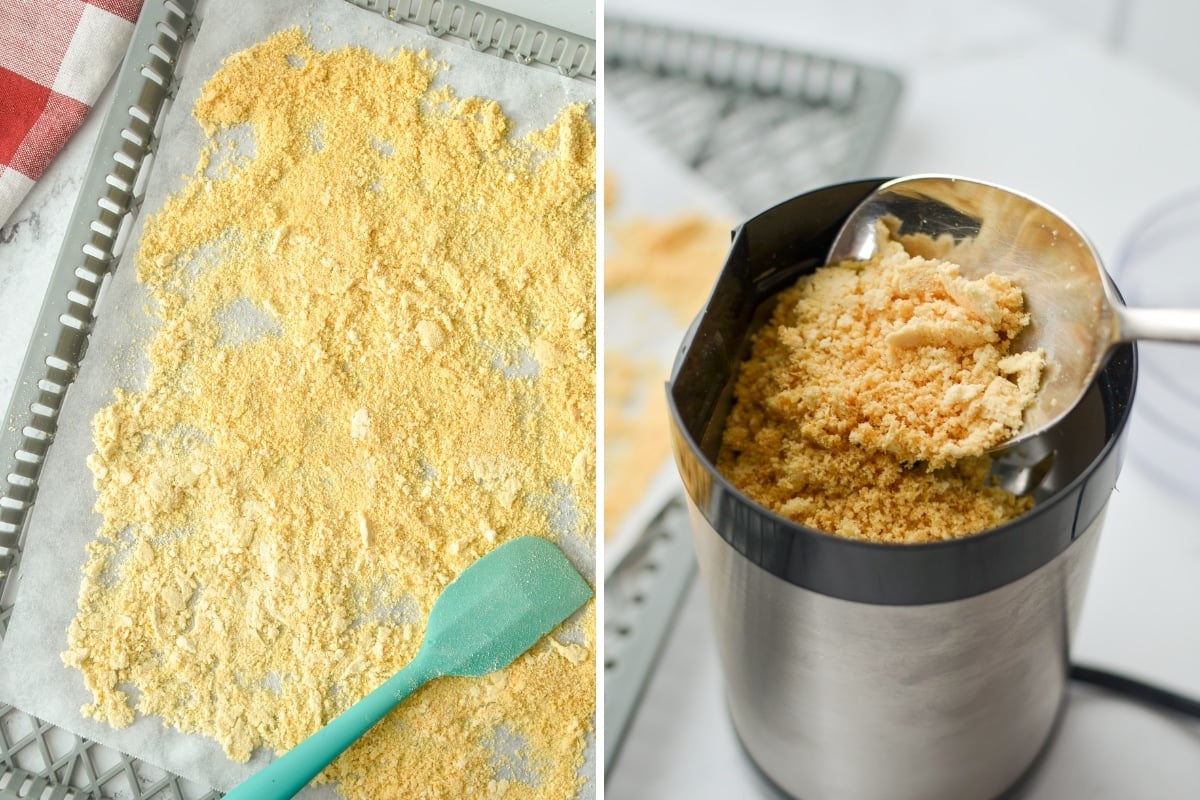
Spread the ground onion powder onto a parchment lined dehydrator sheet, spreading it out in an even layer.
Set the dehydrator to 125ºF (52ºC) and dry for an additional 4-8 hours. Then allow it to cool completely before transferring batches to the spice grinder for a second round.
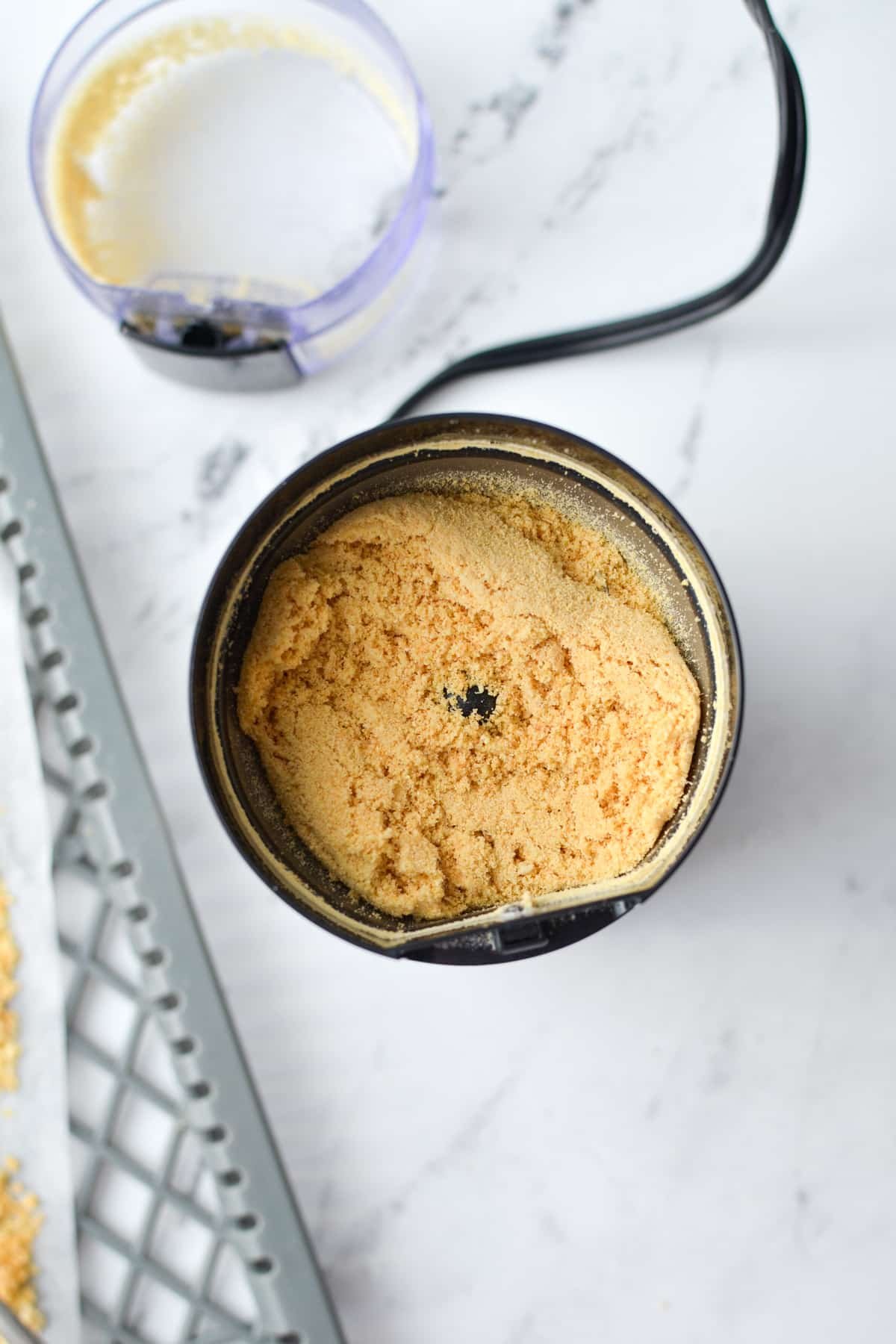
Grind the onion powder to a fine grind, then transfer to an airtight storage container and store for 2-4 months. Storing it with a bit of rice at the bottom of the container may help prevent clumping a bit, but it's not totally necessary.
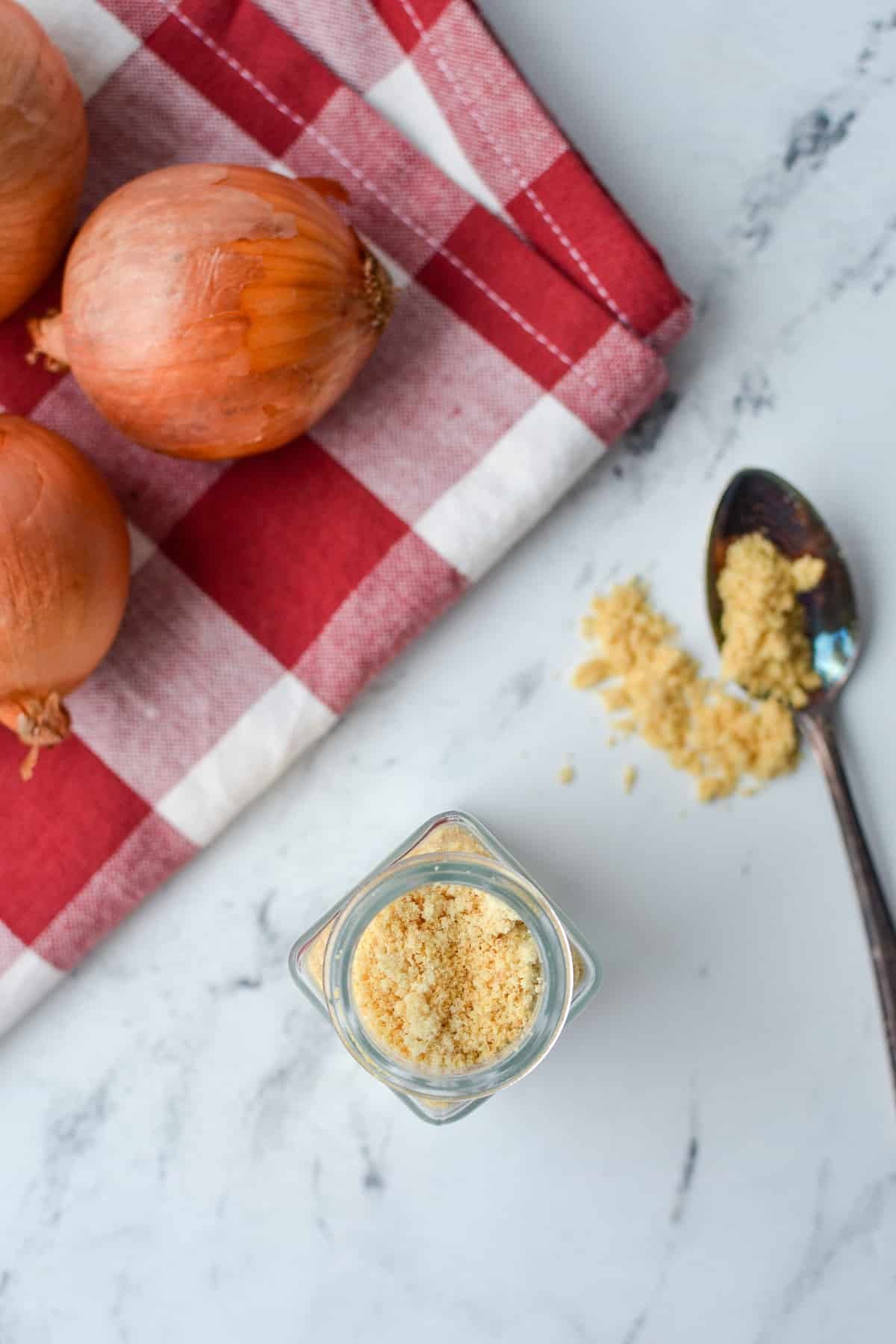
How to Make Onion Powder Without a Dehydrator
If you don’t have a dehydrator – no problem. You can still easily make your own onion powder at home using a low temperature oven. Be sure to check your manual to see how you can configure a lower temperature.
- Set your oven on the lowest temperature (about 140-150ºF/60-65ºC).
- Spread the onion rings or pieces onto parchment-lined baking sheets in a single layer, spacing them evenly and sparsely.
- Dry for 6-12 hours, rotating the sheets several times to ensure even drying.
- Once the pieces are brittle and break easily, remove them from the oven and allow to cool to room temperature.
- Transfer the cooled onion pieces to a jar for conditioning.
- After 24 hours, if no condensation or fogging has occurred, you’re ready for the next step.
- Add the onion pieces to a clean coffee or spice grinder in small batches.
- Grind into a fine powder.
- Transfer to an airtight container and store for 2-6 months.
Note: If the onion powder is very clumpy or moist feeling after the first grind, spread it out onto trays and dry again for 1-3 hours. Then allow the powder to cool before grinding a second time.
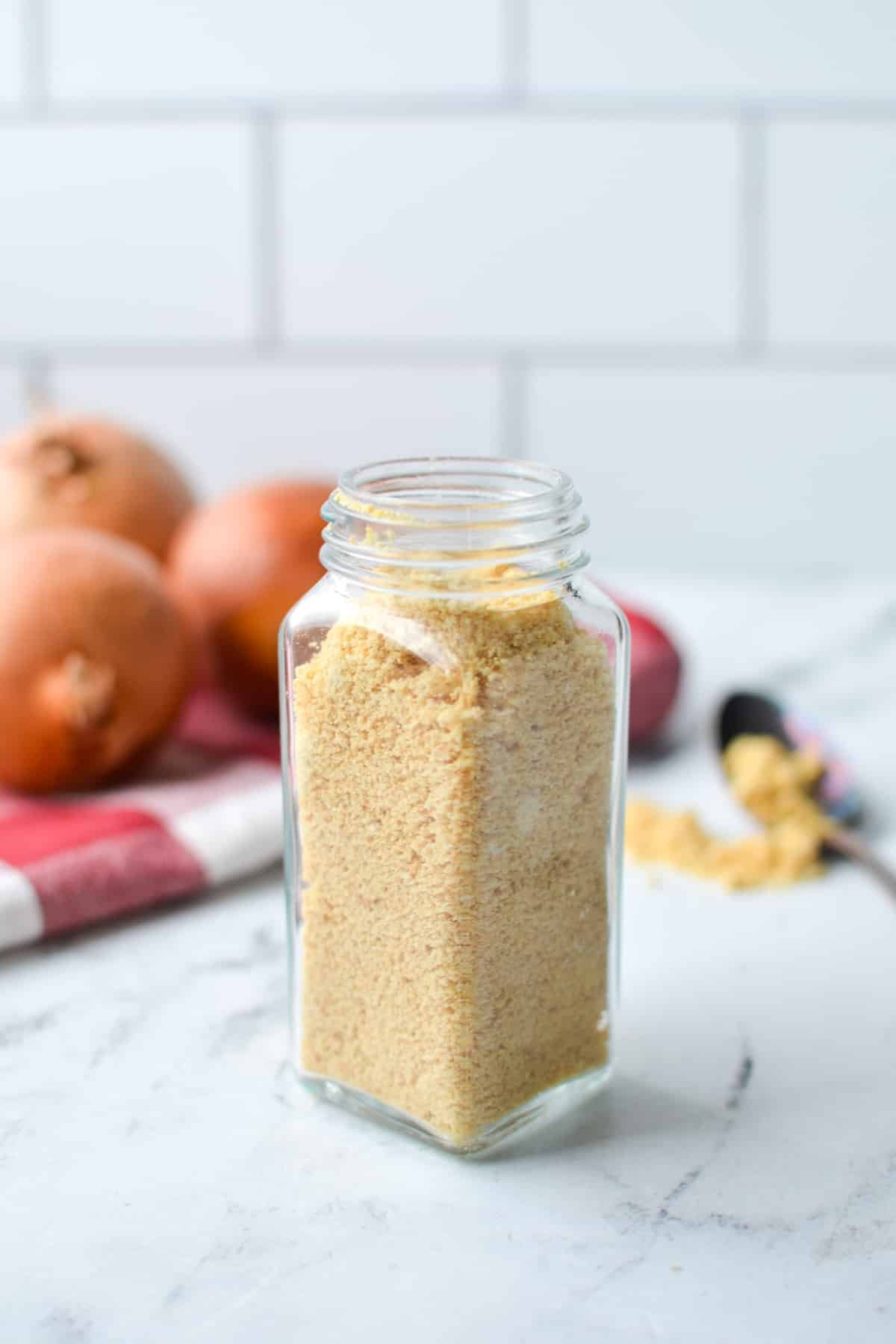
Storing Homemade Onion Powder
Once your onions have been ground into onion powder it will store in an airtight container for about 2-3 months, with the best quality being for the first few weeks. After that it will lose some of its power, and will be quite clumpy, but it is perfectly fine to use.
Some clumping is normal and expected with garlic, shallot, and onion powders. Adding a bit of rice at the bottom of the jar seems to help absorb excess moisture, but it’s definitely optional.
If you want the freshest onion powder possible, I recommend grinding enough to use in 1-2 months and leaving the remaining onion pieces whole. Then grind the remaining whole pieces in batches several times throughout the year.
Onion Powder Equivalent to Fresh
Onion powder is much more concentrated than either fresh or dried onion, so if you would like to use it in a recipe you will have to use far less powder to fresh. I recommend starting with 1 tablespoon of onion powder for every 1 cup of fresh chopped onion called for in your recipe, and then tasting and adjusting for your preferred flavor.
Frequently Asked Questions
The best way to dry onions to make onion powder is by using a dehydrator. Dry the onions for 10-24 hours at 125ºF (52ºC) or until brittle. Once cooled grind the pieces into a fine powder. Now you have your very own homemade onion powder!
Homemade onion powder lasts for 2-3 months, although it is probably just fine for a longer period of time. Onion powder tends to clump very easily, so it tends to harden up after the 3 month mark, making it difficult to use.
Yes, you can make a powder from the skin of an onion, but it does not taste the same as onion powder and shouldn't be used as a substitute. It's more as a means to reduce food waste, so it may be a good addition to flavor broths and soups.
More Dehydrating Recipes
- Dehydrating Garlic
- How to Make Garlic Powder
- Dehydrating Shallots (+ Making Shallot Powder)
- Drying and Dehydrating Basil
📖 Recipe

How to Make Onion Powder
Ingredients
- Onions
Equipment
- Coffee or spice grinder
Instructions
- Peel your onions, ensuring all of the papery skin is removed as well as the membrane layer.
- Slice the onions into thin slices, OR chop into small pieces for making onion flakes. Separate the onion rings for the best and quickest drying.
Dehydrator Instructions
- If your dehydrator does not have a fine mesh tray line each tray with parchment paper or a silicone dehydrator liner.
- Place the sliced or chopped onions in an even, single layer on each dehydrator tray, ensuring that the pieces are not touching each other.
- Set the dehydrator to 125ºF (52ºC) and dry for 10-24 hours, or until the pieces are brittle and easily break in half.
- Once the onions have completely dried turn off the dehydrator and allow the garlic to cool completely to room temperature. You can do this overnight in the dehydrator (turned off and unplugged), or remove the trays to your counter where they will cool quickly.
- Place the completely cooled onion pieces into a glass jar with a lid, placing them in a cool, dry place out of direct sunlight for approximately 24 hours. Shake the jar several times during this period. This is called conditioning.
- If any condensation or fog appears in the jar, transfer the onions back to the dehydrator and dry again until all pieces are brittle and it passes the conditioning test.
- Once the onions have passed the conditioning test, transfer them in batches to a clean spice or coffee mill (dedicated to the purpose of grinding spices and powders) and grind until it forms a fine powder.
- Onion powder is naturally quite clumpy, but if you still find it somewhat moist, there is an option to dry it further, Simply spread the powder on a parchment lined dehydrator tray and dry at 125ºF for an additional 4-8 hours. Then cool and grind again.
- Transfer your onion powder to an airtight jar or container and store it for 2-6 months. Discard if there are any signs of spoilage. Clumping is normal with onion powder, so expect to see that fairly quickly.
- For the best results, grind just enough onion powder for the next month or so, and store the rest of the onion pieces in your pantry. Grind in small batches as needed.
Oven Instructions:
- Set your oven to the lowest possible temperature, which should be approximately 140-150ºF (60-65ºC). You may need to check your manual to see how to configure the lower setting.
- Spread the onion pieces onto parchment-lined baking sheets in a single layer, spacing them out evenly.
- Dry for 6-12 hours, rotating the sheets several times to ensure even drying.
Once the pieces are brittle and break easily, remove them from the oven and allow them to cool to room temperature before transferring them to a jar for conditioning. - Place the completely cooled dried onion pieces into a glass jar with a lid, placing them in a cool, dry place out of direct sunlight for approximately 24 hours. Shake the jar several times during this period.
- If any condensation or fog appears in the jar, transfer the onions back to the dehydrator or oven and dry again until all pieces are brittle and it passes the conditioning test.
- Once the garlic has passed the conditioning test, transfer it in batches to a clean spice or coffee mill (dedicated to the purpose of grinding spices and powders) and grind until it forms a fine powder.
- Onion powder is naturally quite clumpy, but if you still find it somewhat moist, there is an option to dry it further, Simply spread the powder on a parchment lined dehydrator tray and dry at 125ºF (52ºC) for an additional 4-8 hours. Then cool and grind again.
- Transfer the onion powder to an airtight jar or container and store it for 2-6 months. Discard if there are any signs of spoilage.
Notes
Please note that some of my blog posts here at Little Home in the Making may contain affiliate links. If you make a purchase through these links, I will get a small commission at no additional cost to you. See our disclaimer for more information.




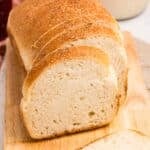
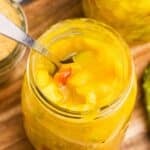



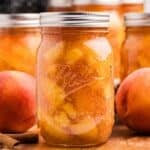



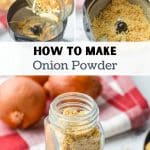
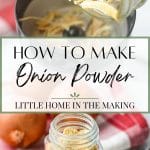
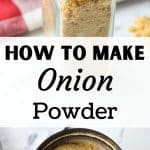
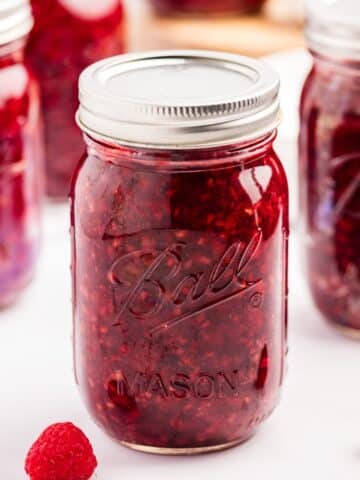
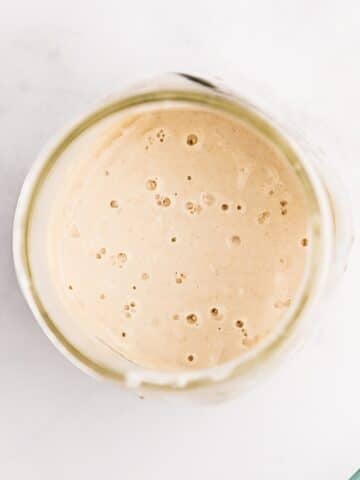
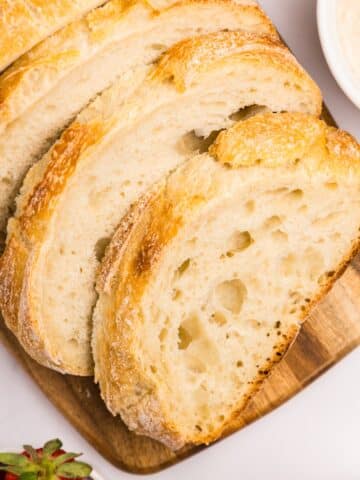

Milord
I'll be sure to remember this process for the post-apocalypse cooking I'll be doing. Oh, wait! There won't be electricity to run my coffee grinder after the bomb hits. Honestly, the cost, time and effort to make your own onion powder is about as impractical as anything I've seen on line so far. I'm pretty sure between the cost of onions, electricity and TIME needed is well beyond the cost of a jar of McCormick's.
Milord
I'm sorry. That was unkind. Forgive me.
Dolly | Little Home in the Making
I wouldn't claim that this was *less* expensive than store-bought. I'm sharing my method so those who want to make their own, can do so successfully. If you grow your own onions or you have some that are going bad, this can be a great way to preserve them.
Cari
I am happy to have found your site. I have recently been drying herbs and really enjoy using them. Mostly ones that I have grown in our garden. I am excited about trying to make onion powder following your directions. Like you said it is a great way to preserve onions that might be going bad. There are those of us who enjoy knowing how and doing it ourselves.
Dolly | Little Home in the Making
Absolutely! It's definitely some work, but it can be satisfying work.
Joyce
just think all those chemicals they used to preserve them that we don't need you won't have it cuz you make your own